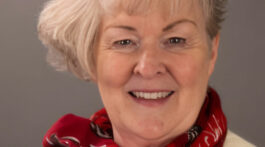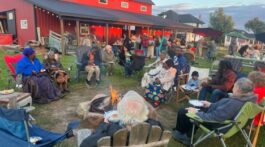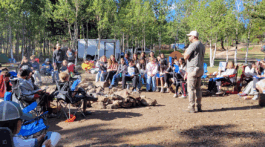In 1943, Ethiopian Emperor Haile Selassie wanted Seventh-day Adventists working in his country. (See article about Della Frances Thompson Hanson.) Following his return to Ethiopia after the Italian occupation, Selassie restored Zauditu Memorial Hospital in Addis Ababa to operation by the Seventh-day Adventist Church, but the Church was finding it difficult to staff the facility. The General Conference was willing to send doctors to the hospital. Dr. Merlin Gustav Anderson was willing to go to Ethiopia and work at the hospital. However, staffing overseas hospitals with American doctors in 1943 was not as simple as appointing and paying the travel expenses of a willing candidate.
The Seventh-day Adventist Doctor’s Conundrum
During World War II, all male physicians, dentists, and veterinarians in the United States were required to register with the Selective Service, just like any other man. However, doctors were not generally subject to being drafted. Instead, doctors were managed by the Federal Security Agency’s Office of Defense Health and Welfare Services, which attempted to balance the Armed Forces’ need for medical professionals with the civilian population’s need for the same medical expertise. Thus, an assignment from the Office of Defense Health and Welfare Services carried the authority of a draft notice. If a doctor was called up for service in the Armed Forces, he was expected to accept a commission as an officer.
This is where the conundrum started. The enlisted soldier who was drafted through the Selective Service Act had legal protection regarding his conscientious objections. This allowed him to request exemptions from carrying weapons and non-essential work on Sabbaths. Waiting to be drafted was the official line of advice from the Seventh-day Adventist War Service Commission headed by Carlyle B. Haynes. He continually stressed the importance of not volunteering but rather waiting to be drafted in order to reserve once’s rights to conscientious objection. Adventist doctors could have followed this advice, but in doing so they would have lost the ability to practice medicine in the Armed Forces, and forfeited the higher wages to which doctors, as commissioned officers, entitled. Although unknown for certain, it is doubtful that any Seventh-day Adventist doctors were enlistees.
Commissioned officers swore (or affirmed) an oath to “support and defend the Constitution of the United States…without mental reservation…and that I will well and faithfully discharge the duties of the office on which I am about to enter.” In time of war, this oath presented two challenges. First, doctors on the front lines were likely to find themselves in situations where they could be ordered to carry a gun. Second, if an Adventist doctor disagreed with his commanding officer about duties he was asked to complete on Sabbath, he could face legal charges and court martial. This happened in at least one case.
Some Adventist physicians avoided the issue for a while by obtaining III-A classification (deferment due to hardship to family or children) under the Selective Service Act, claiming military service would present a hardship for their families. As time went by and the military’s need for medical personnel increased, the pressure mounted. If a physician was of the right age and physical condition to serve in the Armed Forces, he should take a commission, and he would be paid wages ample to care for his family. There was no real hardship. Some Adventist physicians found a successful workaround by writing in an addendum to their statements of oath similar to this one proposed by Haynes:
I have a single reservation which it seems best to disclose now. I am a Seventh-day Adventist. I have no unwillingness to engage in my professional duties in ministering to the sick any day or any time human need requires. I would not, however, have my acceptance of a commission construed as meaning I am willing to compromise my religious convictions regarding merely routine, administrative, ordinary tasks on the seventh-day Sabbath.
Numerous Adventist physicians served during World War II with honor and distinction. According to Haynes, “practically one-half the entire alumni of the College of Medical Evangelists [now Loma Linda University], 700 doctors” was serving in the United States Army in 1944, and most of the rest were providing essential civilian care.It is unknown how many modified their oaths or just accepted the oath in its original form. Very few seem to have run into real disagreement with superior officers. However, there was one more restriction on Adventist doctors’ personal freedoms during World War II. Even if a physician had completed his mandatory military service or had been found unfit for duty, he still could not leave the United States. The Office of Defense Health and Welfare Services, in collaboration with Selective Service and the Department of State, placed an embargo on passports for doctors. And in 1943, this is where Merlin Anderson found himself stuck.
Missionary in Waiting
According to his birth certificate, Merlin Gustav Anderson was born May 22, 1911, in Dusty, an unincorporated community near Colfax, Washington. However, his birthday is often recorded as May 24, 1911, on subsequent documents. His parents were John August Anderson and Ida Henrietta Getzlaff. John was a Swedish-born farmer; Ida was a Minnesota-born housewife, the daughter of German immigrants. Merlin was their only son and the fifth of six children. His sisters were Leona, Mildred, Lorene, Irene, and Bernice. The four older girls and Merlin attended an Adventist church school in Wilcox, Washington, another unincorporated community near Colfax. For such a small school, the Wilcox Church School had an unusually large number of students who became employees of the denomination. This may have been where Anderson’s goal of mission service began.
At Walla Walla College, Merlin Anderson studied premed, then enrolled at the College of Medical Evangelists (CME) from which he graduated in June 1936. That same year, he married one of CME’s nursing graduates, Frances Eleanor Stafford (who went by Eleanor). For a man who desired to become a medical missionary, Eleanor was the perfect wife. Born in Shanghai, China, on December 7, 1912, she was the daughter of Francis Eugene and Ellen Marie “Nellie” (Jessen) Stafford, missionaries to China. After living in the Far East for the first three years of her life, Eleanor’s childhood and teen years had been spent in Honolulu, Hawaii.
The year following graduation from CME was spent in Cedar Rapids, Iowa, where Anderson was an intern at Mercy Hospital. Merlin Gustav, Jr. was born on May 25, 1937, in Mercy Hospital. At the conclusion of Anderson’s internship, he might have applied for the mission field, although he may have also wanted to gain more experience first. Regardless, 1937 was not an auspicious year to seek a position overseas. The General Conference was already becoming cautious about the safety of missionaries. Before too much longer, overseas personnel in many parts of the world would either be recalled or find themselves imprisoned by Axis Powers.
Instead, the Andersons moved to Sikeston, Missouri, where Merlin took up private practice for the next five and half years. He became a well-known figure in the community and satisfied his desire for mission work by assisting with the local Seventh-day Adventist church’s evangelistic outreach. Ronald Eugene joined the family on June 14, 1941.
Along with thousands of other men, Anderson registered with Selective Service on October 16, 1940. Likely due to his age—he was 32 in the autumn of 1942—Anderson was not called to military service until November 1942. He was commissioned a first lieutenant in the Army Medical Corps on November 30, 1942. Not much is known about his months in the Army. Nor is much known about the medical condition that led to his discharge slightly less than a year later. He separated from the Army on October 30, 1943, and his Selective Service classification was changed to 1-C, indicating he was already serving in a capacity that met the needs of the nation’s defense, and he was not subject to conscription. Orders published on October 11, 1943, stated, “You are considered by the War Department to be permanently physically incapacitated for any type of active military service.”
Although this statement sounds like Anderson’s physical condition could have been serious, it must not have been. The General Conference was also concerned that its overseas workers be in good health, and there was no hesitation on the part of the General Conference about sending Anderson to Ethiopia. Anderson himself certainly wanted to go. However, without a passport, he was stuck in the United States. Carlyle B. Haynes appealed Anderson’s case by contacting multiple authorities, including General Lewis B. Hershey at the National Selective Service Headquarters; J. D. Preston, secretary of the United States Senate, and, presumably, personnel at the Office of Defense Health and Welfare Services and the Department of State. Haynes’ typical approach was to meet with officials in person or speak to them on the phone, records of which were not kept. However, Haynes’ extensive correspondence (preserved at the General Conference Archives) provides evidence in the form of thank you letters to these individuals or informative letters to other people involved in the situation, which give us insights into how he advocated for Adventists in tough spots with the military.
Meanwhile, Anderson temporarily worked as a staff physician at the Washington Sanitarium and Hospital in Takoma Park, Maryland. He also used this time to acquire specialized training at Tulane University in New Orleans, in Chicago, and he took a two-week x-ray refresher course in New York City while he waited to sail. Haynes’ appeal on Anderson’s behalf was successful in late 1944. The Andersons finally sailed for Ethiopia in December 1944.
The Life of a Mission Doctor
Merlin Anderson’s life in Addis Ababa was full of long days and a variety of experiences. For at least the first year, he was the only physician on staff. He treated everyone from members of the royal family, who sometimes made significant financial gifts to the hospital, to middle class patients, who paid portion of their expenses, to the poor who attended the free clinics. Rosalie M. was born on April 12, 1946, in Addis Abba, Ethiopia, before the Anderson’s first furlough. James, born on September 7, 1952, completed the family after the family returned to Ethiopia. Eleanor also contributed her nursing skills to the work of the hospital and training Ethiopian nationals in nursing.
The Andersons returned to the United States on furlough in November 1949. During nine or ten months at home, Merlin Anderson took post graduate work at Loma Linda. Both Merlin and Eleanor Anderson represented Ethiopia as delegates to the General Conference Session in 1950. They also managed to visit Sikeston, Missouri, where the local newspaper interviewed Merlin.
On September 12, 1950, the Andersons departed New York City on the Flying Independent bound for Djibouti in route to Ethiopia. In 1953 they made a permanent return to the United States in order accommodate their children’s education. From 1953 to 1955, Merlin Anderson was the staff physician at Southern Missionary College. In 1953 they moved to Yakima, Washington, where Anderson returned to private practice. The Andersons maintained a home in Yakima until 1988. However, they made a least two return trips to Ethiopia. From 1960 to early 1962, they worked at the Adventist hospital in Gimbie. In 1978, they made a visit to Ethiopia, during which they enjoyed reconnecting with old friends and former students.
In 1988, the Andersons moved to Southern California. Merlin died on April 19, 2000, in Riverside, California. He was buried in Riverside National Cemetery. Eleanor died on January 13, 2009, and was buried beside him.










